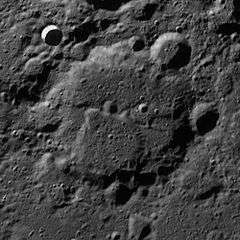Seares (crater)
Seares is a lunar impact crater located in the northern part of the Moon's far side. It lies to the east-northeast of the walled plain Schwarzschild, and to the west of the prominent crater Karpinskiy.
 LRO mosaic | |
| Coordinates | 73.5°N 145.8°E |
|---|---|
| Diameter | 110 km |
| Depth | Unknown |
| Colongitude | 220° at sunrise |
| Eponym | Frederick H. Seares |
The rim of this old crater is worn and battered by impacts, and now forms an irregular ring of peaks, valleys and ridges about the interior floor. The satellite crater Seares B lies across the northeastern rim. There are small craters across several other parts of the rim. The northwestern rim and outer rampart of Seares overlies half of an old crater that is nearly as large in radius.
The interior floor is nearly level in places, but is marked by a multitude of tiny craterlets of various dimensions. A series of ridges, grooves, and small craters forms a band across the central part of the floor from west to east.
Satellite craters
By convention these features are identified on lunar maps by placing the letter on the side of the crater midpoint that is closest to Seares.
| Seares | Latitude | Longitude | Diameter |
|---|---|---|---|
| B | 75.7° N | 149.7° E | 26 km |
| Y | 77.9° N | 139.5° E | 37 km |
References
- Andersson, L. E.; Whitaker, E. A. (1982). NASA Catalogue of Lunar Nomenclature. NASA RP-1097.CS1 maint: ref=harv (link)
- Blue, Jennifer (July 25, 2007). "Gazetteer of Planetary Nomenclature". USGS. Retrieved 2007-08-05.CS1 maint: ref=harv (link)
- Bussey, B.; Spudis, P. (2004). The Clementine Atlas of the Moon. New York: Cambridge University Press. ISBN 978-0-521-81528-4.CS1 maint: ref=harv (link)
- Cocks, Elijah E.; Cocks, Josiah C. (1995). Who's Who on the Moon: A Biographical Dictionary of Lunar Nomenclature. Tudor Publishers. ISBN 978-0-936389-27-1.CS1 maint: ref=harv (link)
- McDowell, Jonathan (July 15, 2007). "Lunar Nomenclature". Jonathan's Space Report. Retrieved 2007-10-24.CS1 maint: ref=harv (link)
- Menzel, D. H.; Minnaert, M.; Levin, B.; Dollfus, A.; Bell, B. (1971). "Report on Lunar Nomenclature by the Working Group of Commission 17 of the IAU". Space Science Reviews. 12 (2): 136–186. Bibcode:1971SSRv...12..136M. doi:10.1007/BF00171763.CS1 maint: ref=harv (link)
- Moore, Patrick (2001). On the Moon. Sterling Publishing Co. ISBN 978-0-304-35469-6.CS1 maint: ref=harv (link)
- Price, Fred W. (1988). The Moon Observer's Handbook. Cambridge University Press. ISBN 978-0-521-33500-3.CS1 maint: ref=harv (link)
- Rükl, Antonín (1990). Atlas of the Moon. Kalmbach Books. ISBN 978-0-913135-17-4.CS1 maint: ref=harv (link)
- Webb, Rev. T. W. (1962). Celestial Objects for Common Telescopes (6th revised ed.). Dover. ISBN 978-0-486-20917-3.CS1 maint: ref=harv (link)
- Whitaker, Ewen A. (1999). Mapping and Naming the Moon. Cambridge University Press. ISBN 978-0-521-62248-6.CS1 maint: ref=harv (link)
- Wlasuk, Peter T. (2000). Observing the Moon. Springer. ISBN 978-1-85233-193-1.CS1 maint: ref=harv (link)